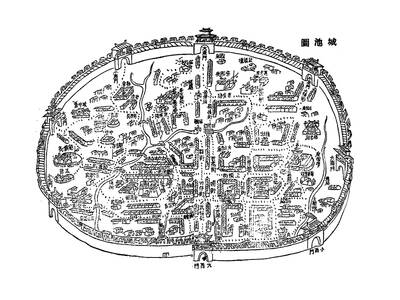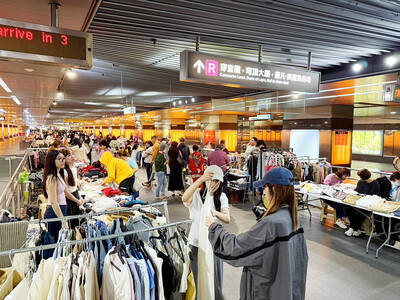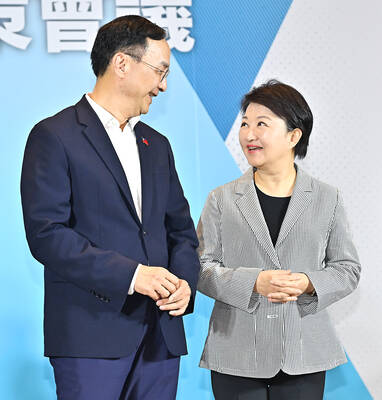With five locations in Taipei, Hi Sushi (海壽司) is a step up in quality (but just a step) above the ubiquitous chain Sushi Express. Both restaurants offer self-serve conveyor belt sushi, but Hi Sushi’s prices are higher and its menu slightly more extensive. The fun of eating in these restaurants is picking plates of sushi as they come gliding past you, but on weekdays and during off hours on weekends, diners in the Hi Sushi in Taipei 101 have to order most of their food off of a menu. Without the novelty of the self-serve format, Hi Sushi’s sushi becomes just inexpensive (and slightly boring) sushi.
The secret to eating at conveyor belt sushi restaurants without accidentally spending a fortune is to load up on lower-priced basics. Hi Sushi does most of the basic nigiri, like eel (鰻魚), squid (花枝) and salmon (鮭魚) well (all NT$60 per plate), with the latter two being standouts for quality. The tuna nigiri (鮪魚), however, was sliced too thin and was generally lifeless with little flavor.
Hi Sushi does a better job with its shellfish sashimi. Its freshwater shrimp nigiri (甜蝦, NT$80) was very sweet and topped with salmon roe, and its scallop nigiri (干貝, NT$100) was also very good. The restaurant’s more adventurous selections, however, are hit and miss. Its lobster salad tasted like a 7-Eleven rice ball when made into nigiri (龍蝦沙拉, NT$40), but was more successful as a hand roll wrapped in crispy seaweed (NT$40). The restaurant was out of California rolls (加州捲, NT$40) every time I visited last week, but the server recommended Hi Sushi jumbo rolls (花壽司, NT$60) as a substitute. The giant sushi roll is stuffed with an assortment of sundry food items including pickles, imitation crab meat and tamago, or cooked egg, but the thunder was taken away from it by the cling wrap that I had to unpeel first and very clammy and hard sushi rice, which made it clear that the roll was not freshly made and had probably made plenty of rounds on the conveyor belt before I got to it.
Hi Sushi also has a couple of items that make liberal use of mentaiko, or marinated cod roe, and mayonnaise sauce including squid with mentaiko (NT$60) and shrimp with mentaiko nigiri (NT$100). On a recent visit, the Taipei 101 Hi Sushi also had bowls of chopped squid meat liberally drizzled in mentaiko (NT$100), which resembled macaroni and cheese, on its conveyor belt. The macaroni probably would have been a better substitute for the squid meat, which was completely lost underneath the very salty and creamy sauce.

May 26 to June 1 When the Qing Dynasty first took control over many parts of Taiwan in 1684, it roughly continued the Kingdom of Tungning’s administrative borders (see below), setting up one prefecture and three counties. The actual area of control covered today’s Chiayi, Tainan and Kaohsiung. The administrative center was in Taiwan Prefecture, in today’s Tainan. But as Han settlement expanded and due to rebellions and other international incidents, the administrative units became more complex. By the time Taiwan became a province of the Qing in 1887, there were three prefectures, eleven counties, three subprefectures and one directly-administered prefecture, with

It’s an enormous dome of colorful glass, something between the Sistine Chapel and a Marc Chagall fresco. And yet, it’s just a subway station. Formosa Boulevard is the heart of Kaohsiung’s mass transit system. In metro terms, it’s modest: the only transfer station in a network with just two lines. But it’s a landmark nonetheless: a civic space that serves as much more than a point of transit. On a hot Sunday, the corridors and vast halls are filled with a market selling everything from second-hand clothes to toys and house decorations. It’s just one of the many events the station hosts,

Among Thailand’s Chinese Nationalist Party (KMT) villages, a certain rivalry exists between Arunothai, the largest of these villages, and Mae Salong, which is currently the most prosperous. Historically, the rivalry stems from a split in KMT military factions in the early 1960s, which divided command and opium territories after Chiang Kai-shek (蔣介石) cut off open support in 1961 due to international pressure (see part two, “The KMT opium lords of the Golden Triangle,” on May 20). But today this rivalry manifests as a different kind of split, with Arunothai leading a pro-China faction and Mae Salong staunchly aligned to Taiwan.

Two moves show Taichung Mayor Lu Shiow-yen (盧秀燕) is gunning for Chinese Nationalist Party (KMT) party chair and the 2028 presidential election. Technically, these are not yet “officially” official, but by the rules of Taiwan politics, she is now on the dance floor. Earlier this month Lu confirmed in an interview in Japan’s Nikkei that she was considering running for KMT chair. This is not new news, but according to reports from her camp she previously was still considering the case for and against running. By choosing a respected, international news outlet, she declared it to the world. While the outside world